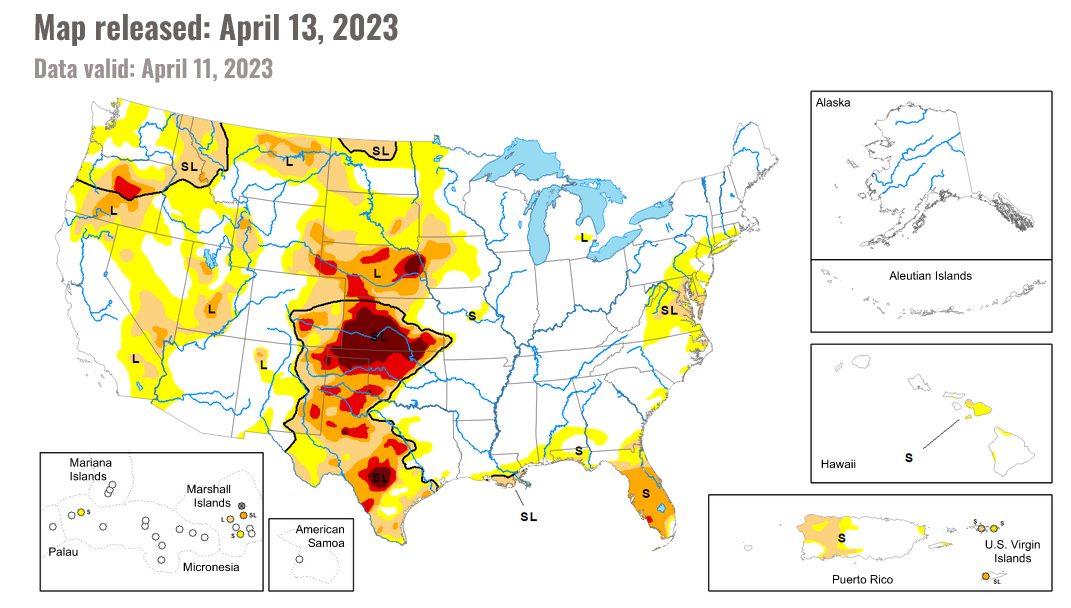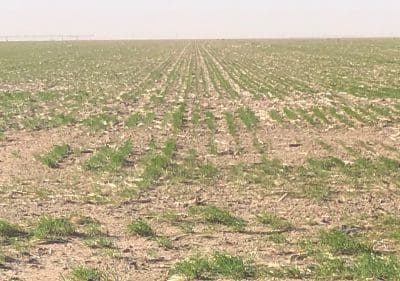
Drought is at its most severe in Kansas and northern Oklahoma. Photo: US Drought Monitor
WINTER wheat harvest prospects in the United States this season are declining rapidly as the drought conditions that have gripped the Southern Plains wheatbelt for much of the past two years continue to deplete soil moisture reserves and erode yield potential in crucial production states.
Wheat markets are generally sensitive to late freezes at this time of year, but it will matter for little if crop-saving rains fail to arrive in the coming weeks and provide essential relief to extremely stressed plants. Susceptibility to diseases such as crown rot, stripe rust and wheat streak mosaic virus, or attack by pests such as aphids and mites, also increase when the plant is stressed. While some districts have received scattered showers this month, much more is needed to turn the situation around, and there is very little in the current forecast to excite growers.
Poor start to April
US crop ratings reported by National Agricultural Statistics Service early last week pegged national winter wheat conditions for the week ending April 9 at 27 per cent good to excellent, against 28pc a week earlier and 32pc a year earlier. The 1pc decrease week on week puts the ratings equal to the worst on record for early April. The ratings cover 18 selected states, accounting for 88 per cent of the area planted last autumn.
Farmers across Kansas, the biggest winter wheat-producing state, which generally accounts for around 25pc of US production, face the biggest challenge. The crop rating came in at just 13pc good to excellent compared to 34pc at the same time last year. The only state with a worse rating is Idaho, with a good-to-excellent rating of 10pc, but it only accounts for around 2pc of the total planted area. At the other end of the scale, 61pc of the Kansas winter wheat crop falls into the poor and very poor crop rating categories, against 32pc on April 10 last year.
Bone dry in Kansas and beyond
The drought monitor data released last week shows that 43.5pc of Kansas is experiencing the most severe drought rating of “exceptional” as of April 11. A further 12.8pc falls into the extreme drought category, and 12.9pc is experiencing severe drought. Collectively, that means that more than 69pc of the state is rated severe drought or worse, with only a pocket in the northeast of the state, which accounts for 12pc of the land mass, under no drought declaration.
While wheat is a resilient plant, consecutive drought years have completely depleted soil-moisture reserves across the state. As the crop emerges from dormancy, it is critical that the plant has immediate access to moisture to recommence the growing process. Last year there was some subsoil moisture for plants to access if they had an established root system, but this year the entire profile across much of Kansas is bone dry.

A wheat crop in need of a drink in Haskell County, Kansas, earlier this month. Photo: Travis Leonard, Leonard Seeds
In the prospective planting report released by the USDA on March 31, Kansas accounted for 21.6pc of the total winter wheat area. Second and third on that list were Texas and Oklahoma, with 17.9pc and 12.3pc, respectively, for a three-state total of 51.8pc of the area planted to winter wheat in the US this season. The big problem here is that both these states are suffering the same fate as Kansas.
In Texas, the good-to-excellent area came in at 17pc, but this was actually 10 percentage points higher than the same week in 2022. The poor and very poor-rated area was 47pc on April 9 compared to 79pc a year earlier. Three Texas counties had their driest March on record. The situation is so dire in the Texas panhandle that many farmers are already calling this season’s crop a complete failure. What wheat did emerge in the autumn had very poor root establishment due to lack of moisture, and it was then hit by freezing temperatures over the winter.
While the state’s drought status is better than Kansas, last year’s extreme drought left very little in the soil moisture tank, especially in the key winter wheat counties. Last week’s drought monitor data put the exceptional, extreme and severe drought areas at 4.1, 16.2 and 37.6pc of the state respectively for a total of 57.9pc.
The crop ratings in Oklahoma tell an eerily similar story, with 20pc of the planted area rated good to excellent compared to 29pc 12 months ago. The poor to very poor rated area is up significantly from 33pc on April 10 last year to 46pc on April 9 this year.
Although drought conditions have improved across the state in recent weeks, the panhandle and north-western Oklahoma remain in exceptional or extreme drought. The drought monitor data put 48.6pc of the state in severe drought or worse. Most western counties have not received rain for more than 40 days, and parts of the panhandle county of Texas have gone almost eight months without precipitation.
Conditions negate larger area
Despite the 13pc increase in US winter wheat planting this season, production is likely to be lower than last year. The damage has definitely been done at the top end of the yield curve in many regions, and a substantial change in the weather pattern is required to salvage an average crop nationally. While it is only two months until harvest, it is far too early to put a figure on winter wheat abandonment.
However, with poor crop establishment in the autumn followed by a hot, dry and windy spring, it is probably fair to say that it will be much higher than usual.
The fate of the winter wheat area is sure to engage the spring wheat market. The US needs to ensure that all of the 4.28 million hectares of intended plantings, or 21.2pc of the total US wheat area, actually get seeded over the next few months. It is very early days for the spring wheat program, but the poor winter wheat production outlook puts added pressure on the key states of North Dakota, Montana and Minnesota to plant and produce this season.

HAVE YOUR SAY